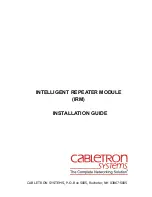
LP-314 Rev. 012 Rel. 003 Date 9.27.19
27
Contractors must check state and local codes before installing
through an existing vent opening. State and local codes always
take precedence over manufacturer’s instructions. Failure to
check state and local codes before installing through an existing
opening could result in property damage and add significantly to
installation costs.
If an existing venting system is converted for use with this
appliance, the installer must ensure that the existing venting
system is clean and free from particulate contamination that could
damage the appliance. Failure to do so could result in property
damage and appliance failure. Such failure IS NOT covered under
warranty.
Concentric Venting Through an Existing System
NOTE: The following instructions refer only to venting through
an existing vent system, and not to venting with HTP’s optional
concentric vent kits. Refer to Concentric Vent Kit installation manual
(LP-166) for further information on venting with the optional
concentric vent kits.
Concentric venting through an existing system must run vertically
through the roof. Use only the approved venting materials specified
in Table 4 for piping the system. All instructions listed in this Venting
section apply. See Figures 18-1 and 18-2 for venting demonstrations.
The upper and lower vent terminations as well as all joints in
the venting system must be properly sealed to ensure that all
combustion air is drawn properly and exhaust does not leak from
the system. Failure to properly seal the venting system will result
in property damage, serious personal injury, or death.
Chase Venting Through an Existing System
When venting as a chase, follow all instructions included in this
Venting section, including those in the previous Concentric Venting
Through an Existing System section. See Figure 18-3 for chase
SEAL
SEALED
EXISTING
EXHAUST
CAP
(w/SCREEN)
SEAL
AIR INTAKE
SEAL
LP-325-LL
03/15/12
Exhaust
In
take
Concentric Venting through an Existing System
1
12" MIN.
LP-325-MM
03/15/12
EXHAUST
SEAL
w/SCREEN
EXISTING
AIR INTAKE
SEALED CAP
COMBUSTION AIR
COMBUSTION
AIR
SEAL
Concentric Venting through an Existing System
2
In
take
Exhaust
Exhaust
In
take
07/22/13
LP-325-NN
INTAKE
EXHAUST
24"
SEAL
EXISTING
VENT
CAP
SEAL
Exhaust
In
take
Chase Venting through an Existing System
3
Figure 18 - 1, 2 - Concentric Venting Through an Existing System, 3, Chase Venting Through an Existing System
NOTE:
These drawings are meant to demonstrate system venting only. The installer is responsible for all equipment and detailing required
by local codes.
3. Power Venting, Indoor Combustion Air in Confined or
Unconfined Space
This appliance requires fresh, uncontaminated air for safe operation
and must be installed in a mechanical room where there is adequate
combustion and ventilating air.
NOTE: To prevent combustion air
contamination, see Table 2.
Combustion air from the indoor space can be used if the space has
adequate area or when air is provided through a duct or louver to
supply sufficient combustion air based on the appliance input.
Never
obstruct the supply of combustion air to the appliance.
If the
appliance is installed in areas where indoor air is contaminated (see
Figure 19) it is imperative that the appliance be installed as direct vent
so that all combustion air is taken directly from the outdoors into the
appliance intake connection.
Unconfined space
is space with volume greater than 50 cubic feet per
1,000 Btu/hour (4.8 cubic meters per kW) of the total input rating of
all fuel-burning appliances installed in that space. Rooms connected
directly to this space, through openings not furnished with doors, are
considered part of the space.
Confined space
is space with volume less than 50 cubic feet per
1,000 Btu/hour (4.8 cubic meters per kW) of the total input rating of
all fuel-burning appliances installed in that space. Rooms connected
directly to this space, through openings not furnished with doors, are
considered part of the space.
When drawing combustion air from inside a conventionally constructed
building to a confined space, such space should be provided with two
permanent openings: one located 6” (15 cm) below the space ceiling,
the other 6” (15cm) above the space floor. Each opening should have a
free area of one square inch per 1,000 Btu/hr (22cm2/kW) of the total
input of all appliances in the space, but not less than 100 square inches
(645cm2).
If the confined space is within a building of tight construction, air for
combustion must be obtained from the outdoors as outlined in the
Venting section of this manual. See Figure 20.
venting demonstration.
















































